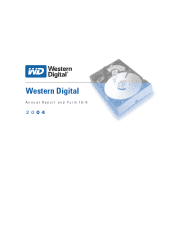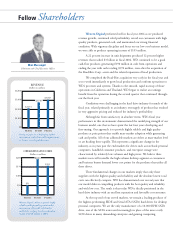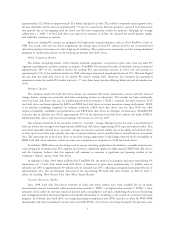Western Digital 2004 Annual Report Download - page 9
Download and view the complete annual report
Please find page 9 of the 2004 Western Digital annual report below. You can navigate through the pages in the report by either clicking on the pages listed below, or by using the keyword search tool below to find specific information within the annual report.approximately $12 billion to approximately $14 billion during this period. This reÖects compound annual growth rates
for unit shipments and revenues of approximately 7% and 4%, respectively. Revenue growth is expected to be lower than
unit growth due to the ongoing trend for lower cost PCs and competition within the industry. Although the average
selling prices (""ASPs'') of hard disk drives are expected to continue to decline, the demand for overall product quality
and reliability continues to increase.
Most new desktop PC systems are equipped with high-speed external interfaces, such as 1394/FireWire/i.Link or
USB. As a result, end users are able to supplement the storage space of their PC systems with the use of external hard
disk drive products that connect via these high-speed interfaces. These products are commonly used for storing additional
programs or multimedia content, or for backing up internal hard disk drives.
Mobile Computing Market.
The mobile computing market, which includes notebook computers, is expected to grow faster than any other PC
segment as performance and price continue to improve. TrendFOCUS estimates that sales of notebook systems comprised
approximately 28% of the combined market for desktop PCs and notebook systems in 2003 and will increase to
approximately 39% of the combined market in 2008, reÖecting a compound annual growth rate of 22%. Western Digital
did not ship any hard disk drives to the mobile PC market during 2004. However, the Company has announced
intentions to enter the mobile PC market with new, 2.5-inch form factor product oÅerings before the end of calendar year
2004.
Enterprise Market.
The enterprise market for hard disk drives focuses on customers that make workstations, servers, network attached
storage devices, storage area networks, and other computing systems or subsystems. This market has been traditionally
served by hard disk drives that use the small-computer-systems-interface (""SCSI'') standard. Recently, however, SCSI
hard disk drives are being replaced by SATA and EIDE hard disk drives in certain enterprise storage applications. SATA
is an interface technology supported by industry standards. SATA hard disk drives cost less than SCSI, but oÅer
improved reliability, scalability and performance over EIDE hard disk drives in enterprise environments. TrendFOCUS
estimates that in calendar year 2004, approximately 30% of the enterprise hard disk drive market will utilize EIDE or
SATA hard disk drives, and that this percentage will increase to 43% by 2007.
One example of growth in the enterprise market is ""near-line'' storage. During the past few years, a new disk-based
back-up market has emerged with high-capacity EIDE hard disk drives augmenting SCSI, tape and optical media. This
new trend, popularly referred to as ""near-line'' storage, has become a growth market due to the ability of hard disk drives
to back-up or access data more quickly than tape or optical solutions, and to quickly retrieve critical back-up or near-line
data. The increasing use of hard disk drives in near-line storage applications is also being enhanced by the availability of
EIDE hard disk drive solutions, which are more cost competitive as compared to SCSI hard disk drives.
In addition, EIDE drives are also being used in unique clustering applications for databases, scientiÑc computation,
web caching and electronic mail. This segment has become a signiÑcant market for large capacity EIDE hard disk drives,
and the Company believes that this segment will continue to consume a signiÑcant and growing portion of the
Company's highest capacity hard disk drives.
According to a May 2004 report published by TrendFOCUS, the market for enterprise and other non-desktop PC
applications of 3.5-inch form factor hard disk drives is forecasted to grow from approximately 33 million units in
calendar year 2003 to approximately 83 million units in calendar year 2007, reÖecting a compound annual growth rate of
approximately 26%. For an additional discussion of the non-desktop PC hard disk drive market, see Part II, Item 7,
under the heading ""Risk Factors That May AÅect Future Results.''
Consumer Electronics Market.
Since 1999, hard disk drive-based recorders of audio and video content have been available for use in home
entertainment systems. Commonly called personal video recorders (""PVRs'') or digital video recorders (""DVRs''), these
consumer devices oÅer the end-user enhanced features such as pausing live television, simplifying the process of recording
and cataloging recorded television programs and quickly forwarding or rewinding to any section of a recorded television
program. In addition, hard disk drives are being increasingly incorporated into DVD recorders to allow for PVR/DVR
functionality and faster recording of content onto removable DVDs. New devices are being developed that generate, store
4






















